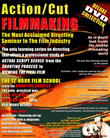|
|
FEATURES
- Film
Editing
|
 |
|
|
|
|
|
|
|
|
| Sponsors |

|
|
|
 |
|
 |

|
|
Film Editing - page 3
|

|
|
The raw footage comes in each day, and the editor shows these "dailies" to the director. "I'm hoping to be able to see in dailies the essential focus of the director's attention, what he was going through on each take. When you first look at the picture, you're looking for the story. The number one object is to keep the story moving, reveal the details of the story, and get the best performances. You make the actors look as good as you possibly can but most of all the objective is
clarity."
The biggest sin is to be redundant. The next biggest is to have things that are truly extraneous. Inevitably it gets back to what to leave in and what to cut out. Carol Littleton tries to cut "things that really do not contribute to the through-line of the picture."
The best editing is usually invisible. The effect that I always try for is that it looks as if it comes straight out of the camera that way, so you're not aware of all the cuts.
The editor must resist the temptation to "overcut" in an attempt to get in every cherished moment.
Once the production has wrapped, the pressure shifts to the editor to produce an initial cut of the film.
In the first assembly Joe Hutshing tries to follow the script as closely as possible. "I try to be true to what was written and try to make it work, exactly as the script has it. Once that has been done then you can start making interpretations of it, refining it." Carol Littleton also states that there comes a time when the editor must be willing to let go of the script.
Editors are put in a position many times of sharing the knowledge they have of objectivity with directors who may have less, and guiding them through the treacherous labyrinth of making a movie. Many times directors become so emotionally attached to a project that they do not see faults that others observe. Editors are now more involved in the dissemination of knowledge than they had been in the past. Editors, cinematographers, production designers, and so on essentially have more experience than directors do.
|
|

|

|
|
Oliver stone tries to remain as flexible as possible and considers the editing process itself "the last rewrite."
|
|

|
|
|
While a director may spend years putting a single project together, editors spend weeks on it and then move on. "When I'm in the dark, alone, and I'm looking at the film for the first time, it's very exciting. Then when the director comes in, you're dealing with the mind and heart of the person who has the most intimate knowledge of the film. You go through problems together, talk, hash it over, find solutions. It's you two at the end. It really is magic. We're sort of alchemists. We put a lot of elements together, and we're hoping to make it gold."
Oliver stone tries to remain as flexible as possible and considers the editing process itself "the last rewrite." Often he will edit individual scenes so that the dialogue is delivered in an order very different from how it was scripted and shot. Indeed, the use of multiple editors has become something of an Oliver Stone trademark.
Hutshing doesn't mind. "I enjoy the collaboration and I also like to see what other editors can do. I make a pass on a scene and give it to somebody else. I can get bored with scenes so if you're switching around with another editor, for me, it's actually a lot of fun."
Increasingly, the image of the editor working "alone in the dark" is being replaced with the reality of multiple editors. Hutshing attributes this to postproduction times pressure. "I think the studios want to see a return on their money faster, so a way of shortening the time is to put multiple editors on each project."
If actors can inspire one another to do their best work, why not editors? It provides another example of how the art of filmmaking is increasingly collaborative in nature.
Editors and directors tend to form long-term relationships and work together on many projects. each knows what to expect from the other. Each has certain needs that must be fulfilled if the collaboration is to be successful. What the editor really wants from the director is coverage- enough material to work with because the director is producing the material from which a movie is going to be made. If you have coverage, you have flexibility. Shooting from several angles, different lighting and focus, and several takes are all essential in providing an editor with adequate film to work with.
|
|

|
|
|
|
|
|
|
|

|
|
|

|

|
|
top of page
|
Home
Page |
Contests
| Indies
| Features
| News
| Resource
Links
| Advertise
With Us |
Important
disclaimer
Copyright ©
1999-2011 by FilmMakers.com. All rights reserved.
FilmMakers.com
is a division of Media Pro Tech Inc.
|

|
|
|